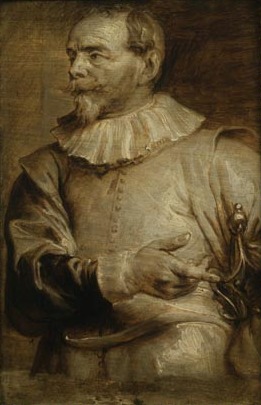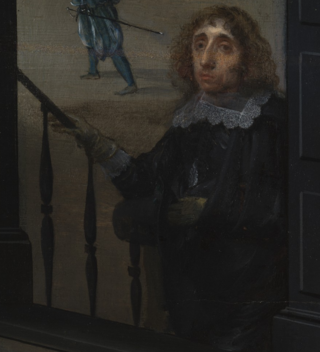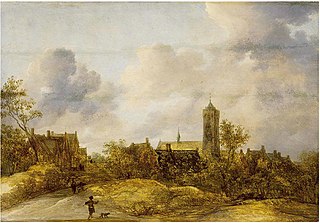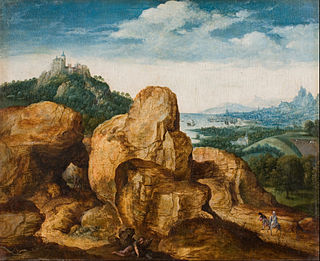
Pieter Bruegelthe Elder was among the most significant artists of Dutch and Flemish Renaissance painting, a painter and printmaker, known for his landscapes and peasant scenes ; he was a pioneer in presenting both types of subject as large paintings.

Joachim Patinir, also called Patenier, was a Flemish Renaissance painter of history and landscape subjects. He was Flemish, from the area of modern Wallonia, but worked in Antwerp, then the centre of the art market in the Low Countries. Patinir was a pioneer of landscape as an independent genre and he was the first Flemish painter to regard himself primarily as a landscape painter. He effectively invented the world landscape, a distinct style of panoramic northern Renaissance landscapes which is Patinir's important contribution to Western art. His work marks an important stage in the development of the representation of perspective in landscape painting.

Lucas van Valckenborch or Lucas van Valckenborch the Elder was a Flemish painter, mainly known for his landscapes. He also made contributions to portrait painting, and allegorical and market scenes. Court painter to Archduke Matthias, the governor of the Spanish Netherlands in Brussels, he later migrated to Austria and then Germany where he joined members of his extended family of artists who had moved there for religious reasons.

Sebastiaen Vrancx, Sebastiaan Vrancx or Sebastian Vranckx was a Flemish Baroque painter, draughtsman and designer of prints who is mainly known for his battle scenes, a genre that he pioneered in Netherlandish painting. He also created landscapes with mythological and allegorical scenes, scenes with robbers, village scenes and celebrations in cities. He was a gifted figure painter who was regularly invited to paint the staffage in compositions of fellow painters. As an active member of a local chamber of rhetoric, he wrote comedies and a number of poems. He was further captain of the Antwerp civil militia schutterij.

Marten Ryckaert or Maerten Ryckaert, was a Flemish landscape painter. He was known for his small, usually imaginary landscapes in an Italianate style.

Frans Francken the Younger was a Flemish painter and the best-known and most prolific member of the large Francken family of artists. Francken painted a range of subjects, producing large altarpieces for churches as well as smaller historical, mythological and allegorical scenes. His depictions of collectors' cabinets established a popular new genre of art in the era. Francken often collaborated with other artists, adding figures and narrative elements to scenes created by specialists in landscape, architectural scenes, and floral still life painting..

Tobias Verhaecht (1561–1631) was a painter from Antwerp in the Duchy of Brabant who primarily painted landscapes. His style was indebted to the mannerist world landscape developed by artists like Joachim Patinir and Pieter Bruegel the Elder. He was the first teacher of Pieter Paul Rubens.

Willem van Haecht was a Flemish painter best known for his pictures of art galleries and collections.

Lodewijk Toeput, called il Pozzoserrato was a Flemish landscape painter and draftsman active in Italy. He is mainly known for his canvases and frescoes of landscapes and formal gardens with banquets and music-making groups. His landscapes had an important influence on the next generation of Flemish landscape artists such as Joos de Momper, Tobias Verhaecht and Gillis and Frederik van Valckenborch.

Jacob Grimmer was a Flemish landscape painter and draughtsman. His rural scenes and landscapes of views around Antwerp marked an important development in 16th century Flemish landscape painting away from the world landscape with its fantastic panoramas and whimsically-shaped gigantic rocks towards greater simplicity and authenticity. His work influenced the next generation of Flemish landscape painters. Grimmer was a capable colorist who was able to create harmonic landscapes by using realistic colours and atmospheric values effectively.

Hendrick van Cleve or Hendrik van Cleve III was a Flemish painter, draughtsman and designer of prints. He is known for topographical views, including views of Rome and the Vatican, as well as imaginary landscapes. Traditionally, a large number of depictions of the construction of the Tower of Babel have been attributed to him but most of these are now attributed to anonymous Flemish painters, who are referred to as 'The Hendrik van Cleve III Group'.

Marten van Valckenborch or Marten van Valckenborch the Elder, was a Flemish Renaissance painter, mainly known for his landscapes and city scapes. He also made allegorical paintings and some portraits. After commencing his career in the Spanish Netherlands, he later migrated to Frankfurt in Germany where he and other members of his extended family of artists played an important role in local artistic developments.

Lucas Gassel or Lucas van Gassel was a Flemish Renaissance painter and draughtsman known for his landscapes. He helped further develop and modernize the landscape tradition in Flanders. He also designed prints which were published by the Antwerp publisher Hieronymus Cock.

Frans de Momper was a Flemish landscape painter who, after training in Antwerp, worked for a while in the Dutch Republic. Here he was exposed to the work of Dutch landscape painters such as Jan van Goyen. His later paintings prefigure the imaginative landscapes of Hercules Segers.

Philips de Momper the Elder, Philips de Momper (I) or Philippe de Momper (I) (1598–1634) was a Flemish landscape painter and son of the prominent landscape painter Joos de Momper. His work was virtually unknown until a group of paintings, mainly depicting Treviso and Rome, which had formerly been attributed to his father were re-assigned to him. The artist is often confused with his cousin Philips de Momper the Younger (or Philips de Momper (II)) (c. 1610-1675).

The world landscape, a translation of the German Weltlandschaft, is a type of composition in Western painting showing an imaginary panoramic landscape seen from an elevated viewpoint that includes mountains and lowlands, water, and buildings. The subject of each painting is usually a Biblical or historical narrative, but the figures comprising this narrative element are dwarfed by their surroundings.

Cornelis Massijs, was a Flemish Renaissance painter, draughtsman and engraver, mainly known for his landscapes and, to a lesser extent, genre scenes and portraits. He is regarded as an important figure in the transition from the fantastic landscapes of Joachim Patinir to the 'pure landscapes' of later Netherlandish landscape painting.

Tobias' Journey is an oil-on-panel painting by Flemish artist Joos de Momper. The painting showcases Momper's large scale, imaginary landscape painting and his interpretation of perspective in distant views while at the same time treating a biblical subject. The painting depicts the story of Tobit, a righteous Israelite of the tribe of Naphtali, living in Nineveh, who is sent to recover is father's money to Media, escorted by the Archangel Raphael. The painting is currently housed at the Rockox House in Antwerp.

Alpine Landscape is an oil-on-canvas painting by Flemish painter Tobias Verhaecht. The painting was completed between 1600 and 1615, and is now in the Museum of Prado in Madrid.

Landscape with Venus and Adonis is an oil-on-canvas painting by Flemish painter Tobias Verhaecht. The work was probably painted in the 1600s, and is now in the Thyssen-Bornemisza Museum in Madrid.





















